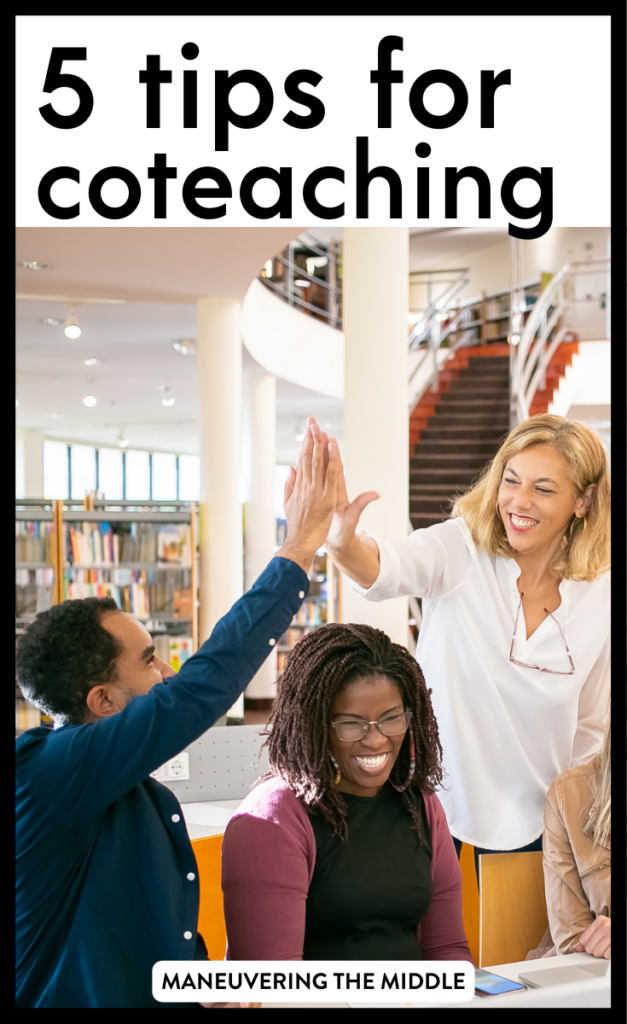Co-teaching is a great opportunity to reach more students by having an additional educator in the classroom. Let’s talk about ways to create a successful co-teaching relationship!
Note: These tips are more general in nature. Please follow any guidelines provided to you by your school or district.

Inside of the Classroom
Be Inclusive
My first experience in co-teaching was when I was hired in the middle of the year to support an Algebra 1 class. The Algebra 1 teacher made sure I felt like it was also my classroom the day I arrived. My name was on the board, and she ended each lesson by asking, “Mrs. Brack, did I miss anything?” It wasn’t her classroom; it was our classroom.
Try New Methods
There are 6 methods of co-teaching:
- One Teach, One Observe – The observer is gathering information to be analyzed together at a later time.
- One Teach, One Assist – The assistant circulates to provide additional help.
- Parallel Teaching – Both teachers are teaching the same information, but to two different groups simultaneously.
- Station Teaching – Both teachers teach different information to a different group and then repeat instruction to the subsequent group of students.
- Alternative Teaching – One teacher takes on the large group while one teacher works with a smaller group.
- Team Teaching – Both teachers are delivering instruction at the same time together.
While it can be easy to fall into One Teach, One Observe or One Teach, One Assist, I recommend trying each method at least one time. My personal favorite was Station Teaching. Specifically, for skills with multiple ways to solve. For example, one teacher models solving equations with algebra tiles while the other demonstrates solving equations with the algorithm. Additionally, this creates opportunities for grouping students in a way that can target specific needs.
Here are a few ways our MTM Team Members co-taught:
“We planned a lot of small group instruction so we could each take a few groups, instead of one person taking all of the groups (not enough time). We would each try to have a “low, medium, high” group in an effort to finish at the same time.” – Marissa
“We planned a few days where the co-teacher got to teach the entire lesson. She would also walk around and help all students. That way they felt there were 2 teachers in the room, not just one teacher and someone else they didn’t really have to listen to or who was only there for certain kids. When either of us were teaching we would ask the other if they had anything to add.” – Ashleigh
“During independent work time, we would often sit at different tables in the room (teacher table and small group table) and pull small groups of students (low, medium, high) to do a reteach if necessary or assist in any way. We would each take turns walking the room and checking on students working independently.” – Jenna
Align Yourself on Classroom Expectations
Everyone runs a classroom differently, so upfront communication about expectations, routines, and procedures is non-negotiable. I recommend going through this Routine and Procedure blog post to discuss how you want your classroom to look like, sound like, and feel like. Students need consistency, and both teachers must agree on expectations and how to follow up if expectations aren’t met.
Outside of the Classroom
Meet Weekly
With both of my co-teachers, we had a scheduled sit-down time once a week. We used this time to plan for the upcoming week, divide responsibilities, look at student work, and discuss student progress. While I did the bulk of the lesson planning, it did give my co-teacher opportunities to give me feedback about the lesson or provide additional ideas.
Build Your Relationship
Building relationships with your students is vital! Building a relationship with your co-teacher is just as important. Go to Happy Hour! Find out their coffee order! Learn their dog’s name! Building that rapport will be seen and felt by your students.
Do you have a co-teacher? What tips do you have for co-teaching?



